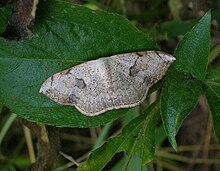| Somatina | |
|---|---|

| |
| Somatina cf. plynusaria | |
|
Scientific classification
| |
| Domain: | Eukaryota |
| Kingdom: | Animalia |
| Phylum: | Arthropoda |
| Class: | Insecta |
| Order: | Lepidoptera |
| Family: | Geometridae |
| Tribe: | Scopulini |
| Genus: |
Somatina Guenée, [1858] [1] |
| Synonyms | |
| |
Somatina is a genus of moths in the family Geometridae first described by Achille Guenée in 1858.
Description
The genus is similar to Problepsis, but differs in that the antennae of the male usually being ciliated. Forewings with vein 10 arising from veins 7, 8 and 9 anastomosing (fusing) with vein 11, and then with veins 8 and 9 to form a double areole. [2]
Species
- Somatina accraria Swinhoe, 1904
- Somatina anthophilata Guenée, [1858]
- Somatina apicipuncta Prout, 1915
- Somatina centrofasciaria (Leech, 1897)
- Somatina chalyboeata (Walker, 1869)
- Somatina ctenophora Prout, 1915
- Somatina densifasciaria Inoue, 1992
- Somatina discata Warren, 1909
- Somatina eurymitra Turner, 1926
- Somatina figurata Warren, 1897
- Somatina fletcheri Herbulot, 1958
- Somatina fraus Prout, 1916
- Somatina fungifera Warren, 1909
- Somatina hombergi Herbulot, 1967
- Somatina impunctulata (Warren, 1901)
- Somatina ioscia Prout, 1932
- Somatina irregularis (Warren, 1898)
- Somatina lemairei Herbulot, 1978
- Somatina lia Prout, 1915
- Somatina macroanthophilata Xue, 1992
- Somatina maeandrata Prout, 1925
- Somatina mozambica (Thierry-Mieg, 1905)
- Somatina nigridiscata (Warren, 1896)
- Somatina obscuriciliata Wehrli, 1924
- Somatina omicraria (Fabricius, 1798)
- Somatina ossicolor Warren, 1898
- Somatina plynusaria (Walker, [1863])
- Somatina postlineata (Warren, 1899)
- Somatina probleptica Prout, 1917
- Somatina prouti Janse, 1934
- Somatina purpurascens Moore, [1887]
- Somatina pythiaria (Guenée, [1858])
- Somatina rhodochila Prout, 1932
- Somatina rosacea Swinhoe, 1894
- Somatina rufifascia Warren, 1896
- Somatina sanctithomae Herbulot, 1958
- Somatina sedata Prout, 1922
- Somatina sublucens (Warren, 1907)
- Somatina subviridata (Warren, 1901)
- Somatina syneorus Prout, 1915
- Somatina transvehens Prout, 1918
- Somatina vestalis (Butler, 1875)
- Somatina virginalis Prout, 1917
- Somatina wiltshirei Prout, 1938
References
Wikimedia Commons has media related to
Somatina.
Wikispecies has information related to
Somatina.
- ^ Sihvonen, Pasi (April 1, 2005). "Phylogeny and classification of the Scopulini moths (Lepidoptera: Geometridae, Sterrhinae)". Zoological Journal of the Linnean Society. 143 (4): 473–530. doi: 10.1111/j.1096-3642.2005.00153.x.
- ^ Hampson, G. F. (1895). The Fauna of British India, Including Ceylon and Burma: Moths Volume III. Taylor and Francis – via Biodiversity Heritage Library.
External links
- Pitkin, Brian & Jenkins, Paul. "Search results Family: Geometridae". Butterflies and Moths of the World. Natural History Museum, London.
| Somatina | |
|---|---|

| |
| Somatina cf. plynusaria | |
|
Scientific classification
| |
| Domain: | Eukaryota |
| Kingdom: | Animalia |
| Phylum: | Arthropoda |
| Class: | Insecta |
| Order: | Lepidoptera |
| Family: | Geometridae |
| Tribe: | Scopulini |
| Genus: |
Somatina Guenée, [1858] [1] |
| Synonyms | |
| |
Somatina is a genus of moths in the family Geometridae first described by Achille Guenée in 1858.
Description
The genus is similar to Problepsis, but differs in that the antennae of the male usually being ciliated. Forewings with vein 10 arising from veins 7, 8 and 9 anastomosing (fusing) with vein 11, and then with veins 8 and 9 to form a double areole. [2]
Species
- Somatina accraria Swinhoe, 1904
- Somatina anthophilata Guenée, [1858]
- Somatina apicipuncta Prout, 1915
- Somatina centrofasciaria (Leech, 1897)
- Somatina chalyboeata (Walker, 1869)
- Somatina ctenophora Prout, 1915
- Somatina densifasciaria Inoue, 1992
- Somatina discata Warren, 1909
- Somatina eurymitra Turner, 1926
- Somatina figurata Warren, 1897
- Somatina fletcheri Herbulot, 1958
- Somatina fraus Prout, 1916
- Somatina fungifera Warren, 1909
- Somatina hombergi Herbulot, 1967
- Somatina impunctulata (Warren, 1901)
- Somatina ioscia Prout, 1932
- Somatina irregularis (Warren, 1898)
- Somatina lemairei Herbulot, 1978
- Somatina lia Prout, 1915
- Somatina macroanthophilata Xue, 1992
- Somatina maeandrata Prout, 1925
- Somatina mozambica (Thierry-Mieg, 1905)
- Somatina nigridiscata (Warren, 1896)
- Somatina obscuriciliata Wehrli, 1924
- Somatina omicraria (Fabricius, 1798)
- Somatina ossicolor Warren, 1898
- Somatina plynusaria (Walker, [1863])
- Somatina postlineata (Warren, 1899)
- Somatina probleptica Prout, 1917
- Somatina prouti Janse, 1934
- Somatina purpurascens Moore, [1887]
- Somatina pythiaria (Guenée, [1858])
- Somatina rhodochila Prout, 1932
- Somatina rosacea Swinhoe, 1894
- Somatina rufifascia Warren, 1896
- Somatina sanctithomae Herbulot, 1958
- Somatina sedata Prout, 1922
- Somatina sublucens (Warren, 1907)
- Somatina subviridata (Warren, 1901)
- Somatina syneorus Prout, 1915
- Somatina transvehens Prout, 1918
- Somatina vestalis (Butler, 1875)
- Somatina virginalis Prout, 1917
- Somatina wiltshirei Prout, 1938
References
Wikimedia Commons has media related to
Somatina.
Wikispecies has information related to
Somatina.
- ^ Sihvonen, Pasi (April 1, 2005). "Phylogeny and classification of the Scopulini moths (Lepidoptera: Geometridae, Sterrhinae)". Zoological Journal of the Linnean Society. 143 (4): 473–530. doi: 10.1111/j.1096-3642.2005.00153.x.
- ^ Hampson, G. F. (1895). The Fauna of British India, Including Ceylon and Burma: Moths Volume III. Taylor and Francis – via Biodiversity Heritage Library.
External links
- Pitkin, Brian & Jenkins, Paul. "Search results Family: Geometridae". Butterflies and Moths of the World. Natural History Museum, London.